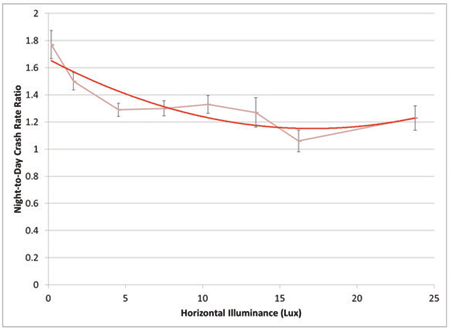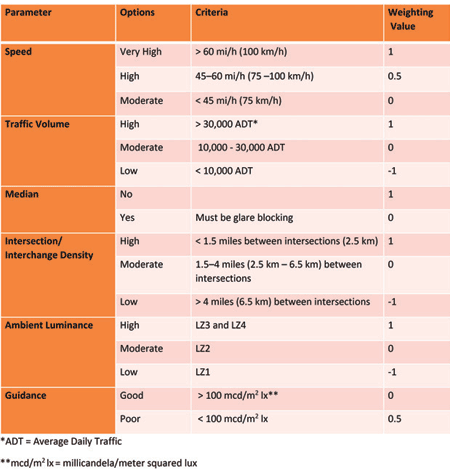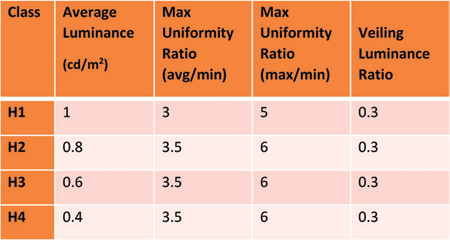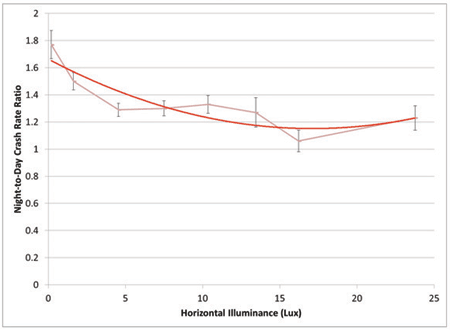By Ronald Gibbons and Rajaram Bhagavathula
Once upon a time, there was a little girl named Goldilocks. She went for a drive in the city. Pretty soon, she came upon three roadways. Goldilocks was worried about the lighting. She tried the first roadway.
“This roadway is too bright and glary!” she exclaimed.
So, she tried the second roadway.
“This roadway is too dark and scary,” she said
So, she tried the last roadway.
“Ahhh, this roadway is just right,” she said happily as she went safely on her way.
Like Goldilocks, designers of roadway lighting systems are looking for the system that is “just right.” New technology and a new approach to selecting roadway lighting requirements might just get us closer to this goal. Adaptive lighting is a methodology for roadway lighting that puts light only where and when it is needed.
For roadway lighting design, we have been unable to provide the exact amount of light we need on a roadway. This is due to some aspects of our design process and the available technology, which results in installed lighting levels that are far above the required maintained lighting level. The current design process requires us to use corrections for the lamp lumen depreciation, dirt depreciation and other factors to calculate the resulting maintained luminance. However, it takes time to reach the maintained value which means that for much of the lighting system’s life, it is functioning over the specified lighting level. Another limitation of the design process is the lamp outputs which have been quantized by wattage. So if we do a calculation and need a 338-W lamp, we would have to round up to a 400-W lamp. Yet another cause for lighting levels above the required values. This additional lighting results in a waste of energy, additional light pollution, and potential health and circadian impacts.
Adaptive lighting is about managing a lighting level as an asset rather than just managing luminaires and poles. Adaptive lighting consists of several different approaches. The first is to set the lighting level to the maintained level when the system is installed. This means that the installed lighting is initially dimmed and adjusted upward as the luminaire output changes with age and dirt. This is the static component of adaptability. The second aspect is to change the lighting level as the needs of the roadway users change. This process implies dynamic adaptability where the lighting system is dimmed based on inputs from the roadway.
COMPONENTS
The first component of adaptive lighting is the lighting control system. The ability to adjust the lighting level is based on the control system. These central control systems are generally referred to as ELMS (Electrical and Lighting Management System) and are integrated with a GIS layout. The control system management software can provide instant feedback on each luminaire and its performance. There is a protocol for communication within the ELMS currently under development. The National Transportation Communications for ITS protocols NTCIP 1213 will provide the basis for standard communication among the luminaires, a central controller and other electrical systems.
The second aspect of the system is a “controls ready” luminaire that can respond to control signals provided by the management system. Generally, a controls ready luminaire is able to turn on and off and dim on command. Most control modules plug into the luminaire through the photocell receptacle in the luminaire and require at least five pins (on, off and dim command connections). Past control systems were wired through a hole in the luminaire but a new specially designed seven-pin receptacle (five currently in use and two for future development) has been approved by ANSI. Most modern luminaire specifications require a seven-pin module.
The final aspect of the adaptive lighting system is an administrative process. As most roadway lighting systems are not metered and the energy usage is paid for in a flat rate, it is difficult for an agency to reap the rewards of the reduced energy usage. An adaptive lighting system must be either metered or have a negotiated tariff. This means that the agency will pay only for the energy used.
FINDING THE RIGHT LEVEL
First, we need to define the right light level, which must match the current traffic, weather and pedestrian needs and provide a safe roadway environment. A luminance selection process is required to calculate the required lighting and for it to be responsive to the needs of the roadway. The luminance criteria depend on the roadway type, the traffic and the roadway design. Very little research exists on the exact relationship of lighting level to safety. Most previous studies have been performed with lighting as a binary value only (present or not present).
In order to investigate the actual needs of the driver, the Federal Highway Administration (FHWA) contracted with the Virginia Tech Transportation Institute to investigate this relationship through a project titled the “Strategic Initiative for the Evaluation of Reduced Lighting on Roadways.” The goal of this project was to establish a link between the lighting level and crash safety and then develop an approach to selecting the lighting level based on the roadway user needs.
During the project, using a mobile lighting measurement system, the luminance levels on 1,000 miles of roadway in seven states were measured then linked to the roadway through a GIS database. This database allows for the user to determine the light level at a given point on the roadway. As a side project, this database has been made public and linked to the existing FHWA Highway Safety Information System.
Efforts are now being made to add more data to the database and provide an access system. More information about this database and how to request and add data will be available in the future. It is expected that as the lighting database becomes more populated, and more and more miles of lighting data become available, a greater number of crashes and various road types can be analyzed, building a stronger knowledge base of the factors that influence the relationship of lighting and crash safety.

Once the luminance levels were measured, the night-to-day crash rate ratio was calculated for each measured roadway segment. These values were then compared to the luminance measurements and analyzed. This crash rate accounted for both the traffic volume and the length of the segment of the roadway under consideration. In all, more than 88,000 crashes over five years—with over 64,000 occurring during the day and close to 24,000 occurring at night (crash times were adjusted for sunrise/sunset times according to the National Weather Service)—were considered in the analysis. The resulting relationship is shown in Figure 1. Here it can be seen that in the unlit portions of the roadway (less than 5 lux), the night-to-day crash-rate ratio increased (it is noteworthy that lighting still exists in these areas but this is spill light from off-roadway facilities). From this general relationship of light and crashes, further investigations into the relationship of the lighting to roadway type, traffic, geometrical design and other factors were performed. Based on these analyses, a luminance selection process was developed.

The luminance selection process was based on a similar process developed by the International Commission on Illumination (CIE). This system was selected to allow for international standardization. The first step in the process is the determination of the roadway type: Roadway, Streets or Pedestrian/Residential.
- Roadways are typically high speed, closed access facilities with no pedestrians.
- Streets are mid-level speed roadways with the potential for pedestrians.
- Pedestrian/Residential facilities are low speed, typically less than 25 mph, and the lighting is typically installed for the pedestrian users.
In the next step in the process, weighting factors for the characteristics of the roadway are used to determine a road class, which then determines the luminance level. Table 1 shows the weighting factors for a roadway class of installation. Here the sum of the weighting factors is subtracted from a base value. The result is an “H” class. This H class is then used with Table 2 to determine the lighting level. Additional tables were created for Street class and Pedestrian/Residential class of roadway. The factors that were added to the tables for the other road classes are Pedestrian level, parked vehicles and facial recognition. The benefit of this form of the selection system is that additional factors can be added and the factors modified as new research becomes available.

It is important to note that adaptive lighting is about dimming and not turning off luminaires. All of the uniformity criteria are still in effect for the roadway.
For a truly dynamic adaptive lighting system, as the weighting factors change, the lighting class would change and the required luminance level would change. The system could then be adjusted to account for the new lighting level. As an example, if the traffic volume or the pedestrian level changed on a street class of roadway, the weighting factor would change and lighting level would be adjusted.
A complete description of this system is provided in the FHWA final report1.
WHEN TO ADJUST
There are two primary approaches to determining when a lighting system should be adjusted: dynamic sensors or time based. For a sensor-based system, the inputs to the luminance selection process are measured in the roadway. Typically this data is available from an ITS system or a roadway monitoring system. If these monitoring systems are not available for an agency, a time-based option can be used. Through sampling of traffic and pedestrian volumes at select times of days, typical times for volume changes can be established. These values are then used to establish when the lighting system can be adapted. The system however should be flexible enough to allow for special events and changing conditions.
SO WHAT CAN WE EXPECT?
The primary result of adaptive lighting is energy savings where reductions as much as 50 percent in usage can be expected. As the luminance selection criteria values are based on the relationship of the lighting to crash safety, it can be expected that these energy savings can be achieved with a minimal impact on safety.
Another potential benefit is that a dimmed solid-state lighting system may cause less circadian disruption than a traditional system, even though SSL lighting can produce more blue light, which causes some non-visual responses to light (blue light is associated with alerting the brain or circadian disruption). In an investigation in the City of Cambridge, MA, after dimming, these effects are estimated to fall below that of the old technology by about 40 percent, reducing the risk of light disruption of sleep and circadian rhythms.
Adaptive lighting approaches have shown to be effective in reducing the negative aspects of roadway lighting while providing significant benefits in energy savings. So like Goldilocks, we have found “just right”: a method to maintain a lighting level at the level required by the roadway environment without wasted energy and light pollution. Hopefully, when Mama, Papa and Baby Bear get here, they will agree.
REFERENCES
1. Gibbons, R., Guo F., Medina, A., Terry, T., Du, J., Lutkevich, P., Corkum, D., and Vetere, P., (2014). Guidelines for the Implementation of Reduced Lighting on Roadways (Report no. FHWA-HRT-14-050). Washington, DC: Federal Highway Administration.


